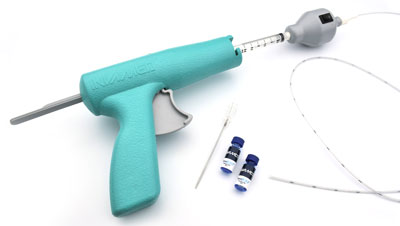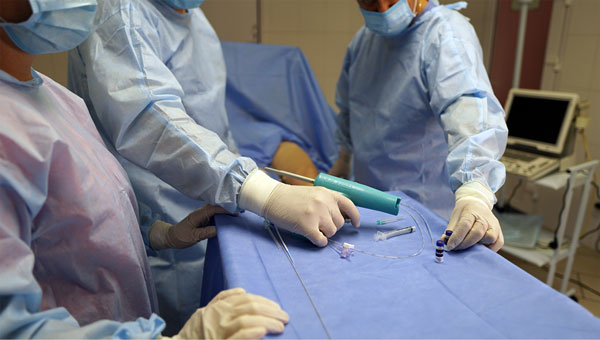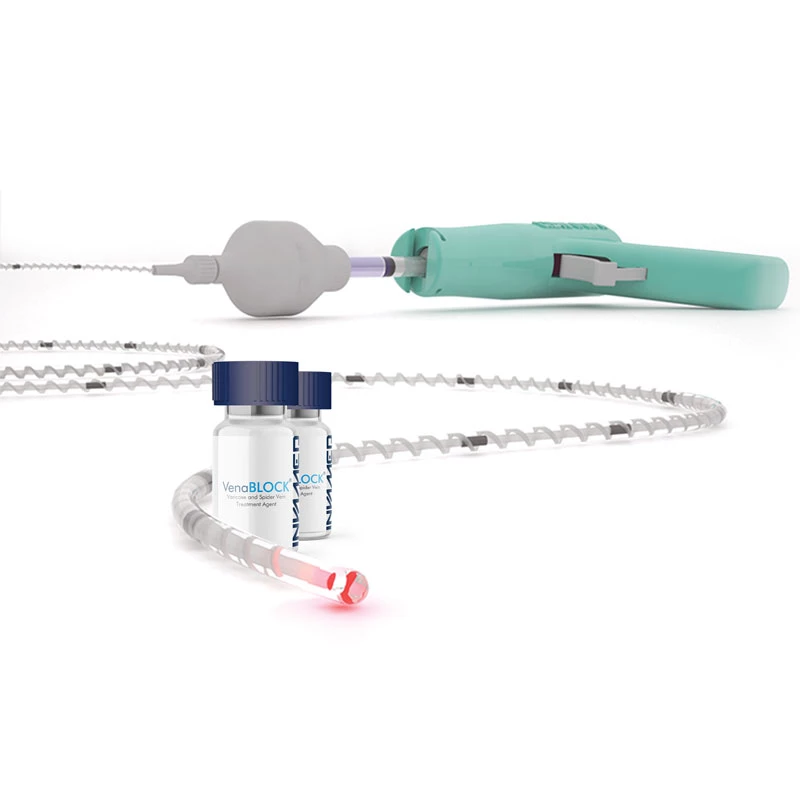Answers of Varicose Vein Closure System VenaBLOCK Varicose Vein Closure System
Illness and prevalence about disease
 Chronic venous insufficiency occurs when your leg veins do not allow blood to flow back up to your heart. Normally, the valves in your veins make sure that blood flows toward your heart. But when these valves do not work well, blood can also flow backwards. This can cause blood to collect (pool) in your legs. Chronic Venous Insufficiency (CVI) commonly affects lower limbs with a prevalence ranging between 25–40% and 10–20% in women and men, respectively. The annual incidence is 2–6% in women and 1.9% in men. The caveat however is the way CVI is defined, which would have an effect on these statistics.
Chronic venous insufficiency occurs when your leg veins do not allow blood to flow back up to your heart. Normally, the valves in your veins make sure that blood flows toward your heart. But when these valves do not work well, blood can also flow backwards. This can cause blood to collect (pool) in your legs. Chronic Venous Insufficiency (CVI) commonly affects lower limbs with a prevalence ranging between 25–40% and 10–20% in women and men, respectively. The annual incidence is 2–6% in women and 1.9% in men. The caveat however is the way CVI is defined, which would have an effect on these statistics.
Causes and symptoms of disease
What causes chronic venous insufficiency?
- Are overweight
- Are pregnant
- Have a family history of the problem
- Had damage to your leg due to injury, surgery, or previous blood clots
- High blood pressure in the leg veins over time, due to sitting or standing for long periods
- Lack of exercise
- Smoking
- A blood clot in a deep vein, often in the calf or thigh (deep vein thrombosis)
- Swelling and inflammation of a vein close to the skin, often in the legs (phlebitis)
What are the symptoms of chronic venous insufficiency?
- Swelling in your legs or ankles
- Tight feeling in your calves or itchy, painful legs
- Pain when walking that stops when you rest
- Brown-colored skin, often near the ankles
- Varicose veins
- Leg ulcers that are sometimes hard to treat
- Having an uncomfortable feeling in your legs and an urge to move your legs (restless legs syndrome)
- Painful leg cramps or muscle spasms (charley horse)
What is features of Varicose Vein Closure System
 The VenaBLOCK closure system is indicated for use in the closure of saphenous veins (vena saphena Magna, valve saphenous Parva) or perforator veins in endovenous treatment of incompetent varicose veins. VenaBLOCK is an n-BCA-polymer structure that was changed by adding a monomer synthesized by the producing company. It is ready for use, blue-colored, transparent liquid. Product show polymerization effect with embolization. When contacted with living tissue and in humid environments, it very fast becomes polymerized by forming a thin, flexible membrane with high tension resistance that ensures sticking firmly to the tissues. The subject matter membrane ensures a natural fit with the structure of the tissues, it is watertight and does not affect the structures of the blood and organic liquids. This formed membrane, since the polymerization of the product does not cause the occurrence of glassy components, can easily be perforated with the surgical needle after it is hardened. The polymerization time changes according to the type of tissue polymer contacted, characteristics of the liquid foundation, and the amount of the product used. When it is applied in the right conditions, VenaBLOCK starts polymerization after 1-2 seconds and finishes the polymerization process in about 5 seconds.
The VenaBLOCK closure system is indicated for use in the closure of saphenous veins (vena saphena Magna, valve saphenous Parva) or perforator veins in endovenous treatment of incompetent varicose veins. VenaBLOCK is an n-BCA-polymer structure that was changed by adding a monomer synthesized by the producing company. It is ready for use, blue-colored, transparent liquid. Product show polymerization effect with embolization. When contacted with living tissue and in humid environments, it very fast becomes polymerized by forming a thin, flexible membrane with high tension resistance that ensures sticking firmly to the tissues. The subject matter membrane ensures a natural fit with the structure of the tissues, it is watertight and does not affect the structures of the blood and organic liquids. This formed membrane, since the polymerization of the product does not cause the occurrence of glassy components, can easily be perforated with the surgical needle after it is hardened. The polymerization time changes according to the type of tissue polymer contacted, characteristics of the liquid foundation, and the amount of the product used. When it is applied in the right conditions, VenaBLOCK starts polymerization after 1-2 seconds and finishes the polymerization process in about 5 seconds.
How to treat and cure process
Before starting to inject VenaBlock polymer into the vein, constant pressure should be applied over the junction, and closure should be confirmed by ultrasound. Before the first injection, the specialist must pressure over the saphenofemoral junction (SFJ) or saphenopopliteal junction (SPJ) to prevent migration of the first bolus polymer into the deep venous system. While pressuring SFJ or SPJ, the first injection of the polymer must be applied continuously. Right after the first injection pressure must be applied for at least five (5) seconds while pressuring SPJ simultaneously. After the venous closure is obtained and the second polymer injection is continuously done, the second pressure shall be applied in the same method.  The pressure technique shall continue until the targeted vein segment is fully sealed. c. Injection of polymer into the vein is a continuous procedure. The delivery gun is set up as: One slow pull of the trigger, while pressing for five (5) seconds, gives 0.3 ccs of polymer. The specialist must draw back the catheter according to the diameter of the target vein. In every five (5) trigger must be pushed again and continuous drawback should be applied simultaneously. This way specialists can apply the polymer to every cm. d. For the diameters ranging from 5.5 to 10 mm, the delivery catheter should be pulled back ten (10) cm during five (5) seconds of polymer injection (2cm/s). For the diameters of 10-20 mm, the delivery catheter should be pulled 5 cm every five seconds (1cm/s). e. After the first injection, pressure must be applied for at least five (5) seconds while pressuring SPJ simultaneously. After the venous closure is obtained and the second polymer injection has been continuously done second pressure shall be applied in the same method. The pressure technique shall continue until the targeted vein segment is fully sealed. f. Pressure areas can be traced easily by following a guiding light at the tip of the delivery catheter. Pressure must be applied right after following the guiding light by 2cm/sec.
The pressure technique shall continue until the targeted vein segment is fully sealed. c. Injection of polymer into the vein is a continuous procedure. The delivery gun is set up as: One slow pull of the trigger, while pressing for five (5) seconds, gives 0.3 ccs of polymer. The specialist must draw back the catheter according to the diameter of the target vein. In every five (5) trigger must be pushed again and continuous drawback should be applied simultaneously. This way specialists can apply the polymer to every cm. d. For the diameters ranging from 5.5 to 10 mm, the delivery catheter should be pulled back ten (10) cm during five (5) seconds of polymer injection (2cm/s). For the diameters of 10-20 mm, the delivery catheter should be pulled 5 cm every five seconds (1cm/s). e. After the first injection, pressure must be applied for at least five (5) seconds while pressuring SPJ simultaneously. After the venous closure is obtained and the second polymer injection has been continuously done second pressure shall be applied in the same method. The pressure technique shall continue until the targeted vein segment is fully sealed. f. Pressure areas can be traced easily by following a guiding light at the tip of the delivery catheter. Pressure must be applied right after following the guiding light by 2cm/sec.
After the procedure, all applied vein segments should be controlled under ultrasound. b. All perforators should be controlled detailed to prevent recanalization over perforators. If there is an open perforator segment or open vein segment, the polymer should be applied with an entry of the injector. The polymer can be applied by 0.1 cc with a small injector and a pressure of five (5) seconds over the perforator or open segment would be enough to closure.
Result and scientific studies
No technical failure and device-related complications were encountered. The anatomic success rate was 100% after procedures. Each treated SSV was occluded on colored Doppler ultrasonography immediately after the procedure, and all veins remained occluded for 2 weeks after the procedure. Partial recanalization was observed in five patients at a 12-month follow-up. Kaplan–Meier analysis revealed an occlusion rate at 6 months and 12 months follow-up were 97.5% and 93.75%, respectively.
